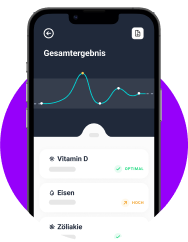The sex hormone testosterone plays a crucial role in a variety of male health functions. When men reach an advanced age, the body’s natural production of this hormone gradually decreases. Only occasionally does the testosterone level drop so much that symptoms and a pathological deficiency (hypogonadism) occur.
It is therefore crucial for those who want to maintain a healthy hormone level to have their own testosterone measured.


When it comes to men’s health, testosterone is one of the most important factors – its powers extend far beyond determining sexual characteristics, as it affects virtually every aspect of life.
Testosterone:
From around the age of 40, a man’s testosterone levels fall continuously by around 1-2%. This is a slow process that some men do not even notice. This process is known as the andropause or, in some cases, the “male menopause”, although of course it cannot be compared with the menopause in women.
To accurately determine low testosterone levels in men and detect hypogonadism, an accurate testosterone measurement is required. Only then can a diagnosis be made and a treatment plan drawn up to improve the patient’s quality of life. Testosterone deficiency can have a negative impact on numerous organ functions and can promote blood pressure and diabetes.
BUT: It should be noted that many of the symptoms mentioned above can also be normal signs of ageing. Only a test can determine whether the testosterone level is actually too low.

Ageing is one of the most common causes of low testosterone levels in men. With increasing age, the body produces less and less of the hormone as part of its natural ageing process.
An unhealthy lifestyle, alcohol, drug or medication abuse, psychological stress or chronic illnesses can promote an early deficiency.
The origin of a testosterone deficiency is divided into two categories.
95% of testosterone production in men takes place in the testicles. Primary hypogonadism is when the hormone-producing cells found there are exhausted and cannot produce enough testosterone. Possible causes include
Testosterone deficiency may be due to a malfunction of the hypothalamus or pituitary gland, which are responsible for hormone production and thus for controlling testosterone production. Possible causes are
The testosterone level in the blood is subject to daily fluctuations. The value is higher in the morning than in the afternoon, for example. It is therefore necessary for the blood sample to be taken in the morning in order to measure testosterone.
Around 97% of testosterone is bound to proteins in the bloodstream, while the remaining 3% circulates as free testosterone. In laboratory tests, luteotropic hormone (LH) and follicle-stimulating hormone (FSH) are used to measure testosterone levels, as they stimulate production in the testicles.
Standard values
Treatment required
Assessment by a doctor required
For the medical history, doctors usually use a well-known questionnaire, the ADAM score (Androgen Deficiency in Aging Men). This questionnaire contains 10 questions that ask you about your current state of mind.
ADAM score questionnaire:
If you have answered “yes ” to more than three questions, this could indicate a testosterone deficiency .

Blood tests are the most common method for analyzing hormone levels. These measurements can be used to determine whether a healthy testosterone level is present in a man’s body.
This allows doctors to assess which treatments are best suited to the individual patient’s needs.
If a testosterone deficiency is detected, there are various remedies that can be used for treatment. Applications include gels for use on the skin, oral medication or injections into the muscles. The injection is usually used for long-term treatment and is also known as the 3-month injection.
Hormone replacement therapy aims to bring testosterone levels back into a healthy range through testosterone substitution.
IMPORTANT:
Testosterone therapy does not stop natural ageing! The prescribed medication is only available on prescription. Too much testosterone in the body can be harmful.
Testosterone plays an important role in men’s health and its production decreases with age. Measuring testosterone is necessary to detect a deficiency that could have a negative impact on organ functions and quality of life.
Low testosterone levels are divided into two categories: primary hypogonadism, which is caused by testicular inflammation or injury, and secondary hypogonadism, which is caused by dysfunction of the hypothalamus or pituitary gland.
With Probatix it is now very easy to have your own testosterone levels checked regularly. Simply register with Probatix Health and make an appointment!

Choose a suitable health test from our wide range of products.
At a Probatix partner near you, a small amount of blood will be taken professionally – usually with a small prick in the fingertip.
Your result will automatically appear in your personal health portal. Including explanations and timelines.